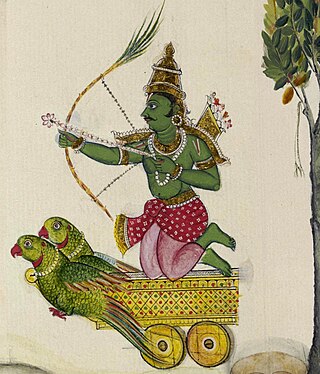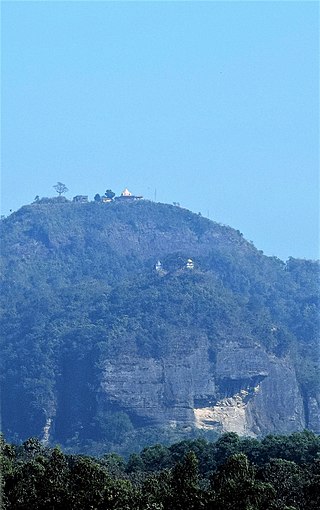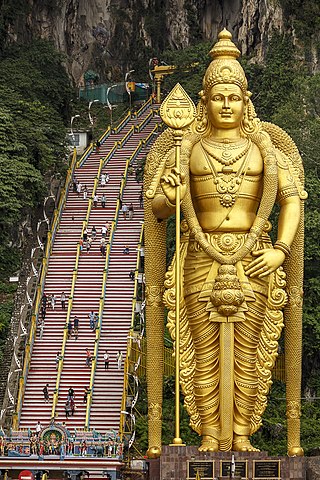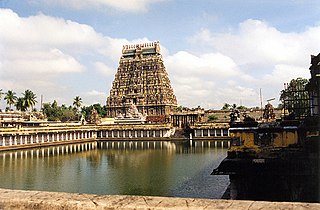
In Hinduism, Daksha is one of the prajapati, the agents of creation, as well as a divine king-rishi. His iconography depicts him as a man with a stocky body and a handsome face or the head of a goat.

Parvati, Uma or Gauri is the Hindu goddess of power, energy, nourishment, harmony, love, beauty, devotion, and motherhood. In her complete form, she is a physical representation of Mahadevi, also known as Adi Shakti, the primordial power behind the creation of the universe, the creator and destroyer. She is one of the central deities of the goddess-oriented sect called Shaktism, and the supreme goddess in Shaivism. Along with Lakshmi and Saraswati, she forms the Tridevi.

Virabhadra, also rendered Veerabhadra, Veerabathira, and Veerabathiran, is a fierce form of the Hindu god Shiva. He is created by the wrath of Shiva, when the deity hurls a lock of his matted hair upon the ground, upon hearing of the self-immolation of his consort, Sati, at the Daksha yajna.

Rati is the Hindu goddess of love, carnal desire, lust, passion, and sexual pleasure. Usually described as the daughter of Prajapati Daksha, Rati is the female counterpart, the chief consort and the assistant of Kama (Kamadeva), the god of love. A constant companion of Kama, she is often depicted with him in legend and temple sculpture. She also enjoys worship along with Kama.

Kama, also known as Kamadeva and Manmatha, is the Hindu god of erotic love, desire and pleasure, often portrayed alongside his consort and female counterpart, Rati. He is depicted as a handsome young man decked with ornaments and flowers, armed with a bow of sugarcane and shooting arrows of flowers.

Kamakhya, a mother goddess, is a Shakta Tantric deity; considered to be the embodiment of Kama (desire), she is regarded as the goddess of desire. Her abode–Kamakhya Temple is located in the Kamarupa region of Assam, India. Originally a Kirata goddess, Kamakhya remained outside Brahmanical influence until at least 7th century CE. Residing on Nilachal hills across the banks of the Brahmaputra river, west of Guwahati in the 10th/11th century Temple rebuilt in 1565 CE, she is worshiped in a non-iconic and un-anthropomorphic form of stone shaped like yoni fed by a perennial stream. The temple is primary amongst the 51 Shakti Peethas, and is one of the most important Shakta temples.

Sati, also known as Dakshayani, is the Hindu goddess of marital felicity and longevity, and is worshipped as an aspect of the mother goddess Shakti. Sati was the first wife of Shiva, the other being Parvati, who was Sati's reincarnation after her death.

The Shakti Pithas or the Shakti Peethas are significant shrines and pilgrimage destinations in Shaktism, the goddess-centric denomination in Hinduism. The shrines are dedicated to various forms of Adi Shakti. Various Puranas such as Srimad Devi Bhagavatam state the existence of varying number of 51, 52, 64 and 108 Shakti Pithas of which 18 are named as Astadasha Maha (major) in medieval Hindu texts.

Saptashrungi or Saptashringi is a site of Hindu pilgrimage situated 60 kilometres (37 mi) from Nashik in Indian state of Maharashtra. According to Hindu traditions, the goddess Saptashrungi Nivasini dwells within the seven mountain peaks. It is located in Nanduri, Kalwan taluka, a small village near Nashik in India. The Marathas and some Hindu tribes worship the goddess from a long time and some worship as their kuldaivat. There are 510 steps to climb the gad. Devotees visit this place in large numbers every day. The temple is also known popularly as one of the "three and half Shakti Peethas" of Maharashtra. The temple is also one among the 51 Shakti Peethas located on the Indian subcontinent and is a location where one of Sati's limbs, her right arm is reported to have fallen. Its half shaktipeeth among three and half shaktipeeth of Maharashtra.
The Julfa Mata Temple is a Hindu temple in the town of Nangal, Rupnagar district, Punjab, in northern India.

Chandranath Temple, located on top of the Chandranath Hill, is a famous Shakti Peeth located near Sitakunda in Bangladesh where, as per Hindu sacred texts, the right arm of Goddess Sati fell. Chandranath Temple is a pilgrimage site for Hindus. Its height about 1,020 feet (310 m) above sea level.

Daksheswar Mahadev or Daksha Mahadev temple is a Hindu temple dedicated to Lord Shiva, located in the town of Kankhal, about 4 km from Haridwar, Uttarakhand, India. It is named after King Daksha Prajapati, the father of Sati. Daksha is one of the fourteen Prajapatis, creator deities, who preside over procreation and are the protector of life in Hindu mythology.
Tarakasura also rendered as Tarakasuran and Tarakasura is a powerful asura in Hindu mythology. He is the son of the asura Vajranga and his wife Vajrangi. Taraka had three sons: Tarakaksha, Vidyunmali, and Kamalaksha, who were known as the Tripurasura. He is known to be slain by Kartikeya.

Kaumaram is a Hindu denomination that primarily venerates the Hindu deity of war, Kartikeya, also known as Kumaran, Murugan, Arumugan, and Subrahmanyan. Devotees of Kumaran, called Kaumaras, also revere members of his family: Parvati, Shiva, and Ganesha, as well his consorts, Devasena and Sundaravalli, the daughters of Vishnu in Tamil tradition. The important theological texts relating to Kumara are a part of the Shaiva agama canon. This sub-tradition is found among the Tamils, Kannadigas, and the Vedda, in South India, Sri Lanka, and among the Tamil diaspora worldwide. The love story of Kumara/Murugan and his wife Valli, a girl from a local tribe, is popular in Tamil Nadu, where Kumara acquired the status of a national god.

Kartikeya, also known as Skanda, Subrahmanya, Shanmukha, and Murugan, is the Hindu god of war. He is the son of Parvati and Shiva, the brother of Ganesha and a god whose legends have many versions in Hinduism. Kartikeya has been an important deity in the Indian subcontinent since ancient times, worshipped as Mahasena and Kumara in North India and is predominantly worshipped in the state of Tamil Nadu and other parts of South India, Sri Lanka, Singapore, Malaysia and Mauritius by Tamils as Murugan.

Iconography of Shiva temples in Tamil Nadu is governed by the Shaiva Agamas (IAST:Āgama) that revere the ultimate reality as the Hindu deity, Shiva. Āgama in the Hindu religious context means a traditional doctrine or system which commands faith. Temple worship according to Āgamic rules can be said to have started during the Pallava dynasty in South India, but they were fully under establishment during the Chola dynasty The temples during the Chola period expanded to Sri Lanka and islands in South East Asia. The temple complex was expanding with niches for various deities on the stipulated sides of the sanctum. Lingam was universalised and prakarams (precincts) with subsequent deities came up. The temple parivara expanded considerably during the Chola period. The niches of following Āgamic rules for building Shiva temples in Tamil Nadu, a South Indian state continues even in the modern era. Some of the prime images like that of lingam, Vinayagar and Parvati are present in all the Shiva temples. Almost all the temples follow the same custom during festivals and worship methods with minor exceptions. Most of the Shiva temples in Tamil Nadu and Sri Lanka are built in Dravidian architecture.
Sugandha Shaktipeeth, a temple of the Goddess Sunanda, is located in the village of Shikarpur, 10 miles north of Barisal, in Bangladesh. This Hindu temple is one of the Shakti Peethas.

Kottiyoor Ulsavam or Kottiyoor Vysakha Mahotsavam is a 27-day annual pilgrimage observed by Hindus commemorating the Mythology of Daksha Yaga. The pilgrimage is similar to the Kumbh Mela of Prayag, where ablutions are performed. The temple and grounds are also known as Dakshina Kasi.

Dakṣayajña is an important event in Hindu mythology that is narrated in various Hindu scriptures. It refers to a yajna (ritual-sacrifice) organised by Daksha, where his daughter, Sati, immolates herself. The wrath of the god Shiva, Sati's husband, thereafter destroys the sacrificial ceremony. The tale is also called Daksha-Yajna-Nasha. The legend forms the liturgical basis of the establishment of the Shakti Pithas, the temples of Mahadevi, the supreme deity of Shaktism. It is also becomes a prelude to the legend of Parvati, Sati's reincarnation, who later marries Shiva.
Devi Adi Parashakti is a mythological television series based on the Hindu texts of the Shiva Purana, the Devi-Bhagavata Purana, the Markandeya Purana, and pan-Indian folktales of the Goddess. The series was created by Siddharth Kumar Tewary, directed by Loknath Pandey and Manish Singh, and produced by Swastik Productions. Rati Pandey plays the role of Devi Adi Parashakti and her incarnations Goddess Sati, and Goddess Parvati. Tarun Khanna played the role of Devi's husband, Lord Shiva with Kanan Malhotra as Lord Vishnu, Devi's brother. The show also features Sonia Singh as Goddess Diti, the main antagonist.

















